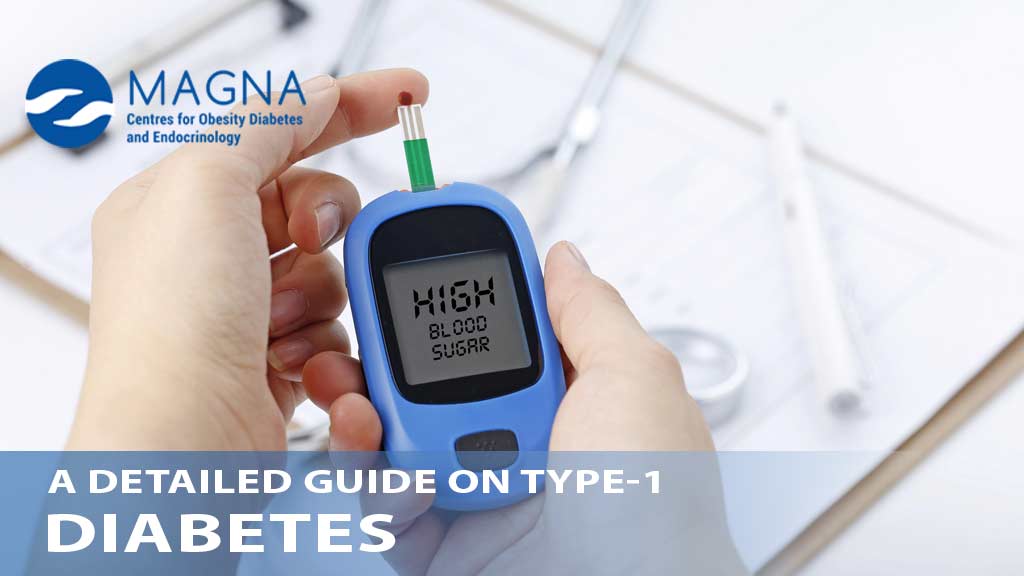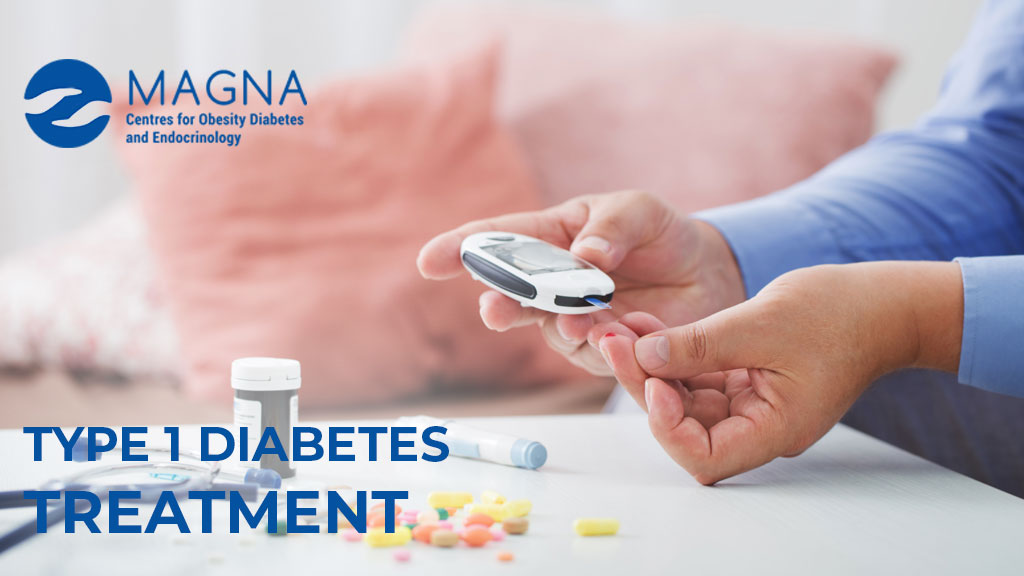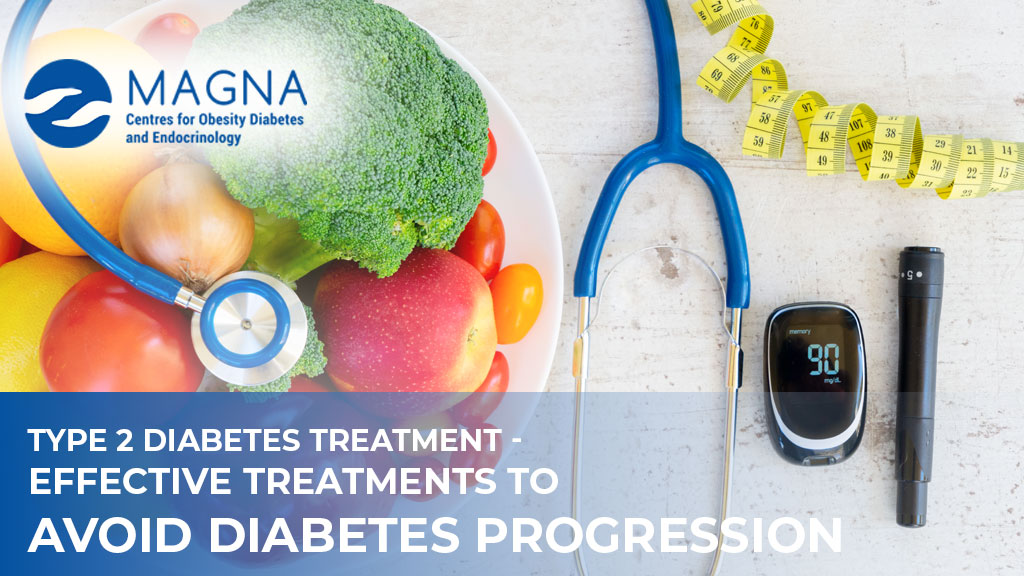June 26 , 2023
A Detailed Guide on Type-1 Diabetes
What is Type 1 Diabetes?
Type 1 diabetes, as the name suggests, is a form of diabetes. So what does this numbering signify? The numbering signifies how the diabetes has been caused in the individual patient. or Diabetes can be broadly caused by four reasons:
- It can be caused by an autoimmune process where the immune system damages the in-su-lin-producing beta cells.
- Genetics and aging can both contribute to it. This is known as type 2 diabetes.
- There is another classification called secondary forms of diabetes, which is diabetes that is caused by specific genetic disorders like Turner syndrome, Klinefelter’s syndrome, Laurence Moon syndrome, Beetle syndrome, etc. In this disorder, we have something known as MODY, or maturity-onset diabetes in young people.
- This form of diabetes is gestational diabetes. It’s a form of diabetes that occurs only during pregnancy and in pregnant women beyond six months of gestational age. So the type of diabetes depends on how the diabetes has been caused in your body, and it does not convey any information regarding its security, its prognosis, or how things will improve or rate after the diagnosis.
Cause of Type 1 Diabetes-
One of the most common or specific causes of type 1 diabetes is autoimmunity, or the body's immune system damaging beta cells. The damage can result in severe in-su-lin deficiency and a patient becoming symptomatic with very high blood pressure.
Having high blood pressure frequently is one of the common type 1 diabetes symptoms. Glucose levels where excessive urination is produced cause a person to feel thirsty, fatigue, develop abdominal pain, and develop diabetic ketoacidosis in an acute medical emergency. It can also present in a milder form where it is difficult to differentiate it from Type 2 diabetes, especially in older patients. So these individuals have slightly elevated blood glucose values, but the signs will increase within a few years to require in-su-lin. This form of diabetes is called LADA, or latent autoimmune diabetes in adults. To determine the exact cause of type 1 diabetes, one can also consult the most experienced diabetes doctor, available at Magna Centre, the best diabetes centre in Hyderabad.
Diagnosis of Type 1 Diabetes
A type 1 diabetes diagnosis can be made by doing an antibody test to detect the presence of autoimmunity. The problem with this test is that it always misses some proportion of patients with type 1 diabetes who have autoimmunity, but the antibodies are absent. So the presence of the antibody would clearly signify the presence of type 1 diabetes, but the absence of the antibody does not signify the absence of type 1 diabetes. So one needs to use a combination of the rate of progression of diabetes, the presence of diabetic ketoacidosis, and the presence of antibodies to diagnose Type 1, and diagnosis can at times be difficult.
How is Type 1 Diabetes Treated?
Once diagnosed, type 1 diabetes is invariably treated with in-su-lin. In addition to type 1 diabetes in-su-lin, there are molecules like pra-mli-ntide and Acar-bose that have been used successfully in the management of type 1 diabetes. in-su-lin, to this day, remains the only treatment for type 1 diabetes that is fairly effective. The mode of in-su-lin delivery can be varied from person to person depending on the patient's needs and abilities.
Can Type 1 Diabetes be Cured?
A complete Type 1 diabetes cure is not possible. This is because the ultimate cause of this type of diabetes is autoimmunity, which is still not properly understood. After a century of research, we are unable to find the mechanism to safely switch off the autoimmune destruction. The problem with using immunosuppressants is that when you suppress the immune system, it tends to produce problems elsewhere in the body while improving type 1 diabetes, and these problems can sometimes be more dangerous than even type 1 diabetes. Islet cell transplantation is a form of treatment for type 1 diabetes, when the in-su-lin production capacity has dipped to a very low extent and it is unable to be managed using other methods of delivering in-su-lin. This involves administering in-su-lin-producing cells from a cadaver donor to recipients. These in-su-lin-producing cells are introduced into the liver of the recipient, and after receiving the in-su-lin-producing cells, the recipient has to take lifelong immunosuppression. Though this method has proven useful in largely improving type 1 diabetes, it does not constitute a cure for type 1 diabetes.
How Often Should Blood Sugar Levels Be Monitored for Type 1 Diabetes?
One of the best ways to monitor type 1 diabetes is to do so as often as possible. Studies have shown a direct correlation between how often the sugars are monitored and how well the HbA1c is controlled and complications are prevented in Type 1 diabetes. For instance, Imagine driving on a crowded road in India with your eyes closed. If you are actually trying to manage your type 1 diabetes without checking your blood glucose, this is again doing the same thing that is driving with your eyes closed. There will be equal chances of both high sugar and low sugar, and you will not be able to make informed decisions. Fortunately for us, technology has vaulted in the last 10 years in the sphere of diabetes monitoring.
Just 20 years ago, one had to wait for 30 seconds to a minute for a glucometer to announce the blood glucose value present at this very moment, but now technology has advanced to the extent that we can have flash glucose monitors that will tell us not only the glucose at this point but also what is going to happen to the glucose over the next 20 to 30 minutes. This is an enormous advantage over just glucose monitoring. This is an enormous advantage over just glucose monitoring. There is also something called continuous glucose monitoring in diabetes. Apart from flash glucose monitoring, wherein the information that is collected continuously regarding blood glucose is sent to the in-su-lin pump. This is the most advanced form of blood glucose checking, but in general, for a patient with type 1 diabetes who is injecting in-su-lin several times a day, a minimum of four times of blood glucose monitoring is recommended as a minimum criterion. So anyone who is doing blood work less than three or four times a day while injecting in-su-lin three or four times a day is definitely not going to be able to achieve the best control that is possible for themselves.
What is Carbohydrate Counting, and Why is it Important for Type 1 Diabetes?
Carbohydrate counting refers to the accurate estimation of the amount of carbohydrate present in a particular meal. The hypothesis behind carbohydrate counting is that patients with type 1 diabetes have an absolute lack of in-su-lin, and in-su-lin is required mainly to control the glucose rise. The glucose rise that happens after the injection of carbohydrates depends, apart from the amount of carbohydrate in the meal, on the composition of the meal, that is, how much fat and protein are there. In addition, carbohydrate also has an impact on blood glucose, but carbohydrate counting simplifies this and assigns a value of carbohydrate per meal and then the amount of in-su-lin that needs to be taken along with that in order to prevent a rise in blood glucose. Though it is slightly imperfect, it is the best tool that is available to control blood flow. Until recently. There were no resources for carbohydrate counting in the Indian diet. But now there are excellent resources for the same which will help in planning type 1 diabetes diet plans.
For example, if you are going to have a breakfast of Idli, chutney, and sambar, the carbohydrate counting of that meal will allow us to estimate how much carbohydrate is in the meal so the carbohydrate can be present in the Idli. Some of it is present in the chutney as well as in the Sambar. So we need to be able to assess the total carbohydrate count and then take the appropriate amount of in-su-lin for it.
One's prior experience using in-su-lin for various weeks will determine whether to consume 6 g or 10 g of carbohydrates. So the amount of in-su-lin one needs to neutralize carbohydrates in the meal depends on their physiology rather than being a fixed quantity. For instance, a 70-kg individual and a 10 kg child will have vastly differing in-su-lin requirements for the same amount of carbohydrate. Through a process of trial and error for any given type 1 diabetes patient, the best diabetologist in Hyderabad at Magna Code can arrive at something called the in-su-lin Corporation. The amount of in-su-lin that is required to neutralize the fixed quantity of carbohydrate is then determined. The next step is to determine the carbohydrate at every meal and give the amount of in-su-lin required for that amount of carbohydrate. Carbohydrate counting is an important skill that patients with type 1 diabetes must possess in order to better manage their condition. There are excellent resources online for carbohydrate counting that one can use to practice this.
Can Physical Activity Help in Managing Type 1 Diabetes?
Physical activity and type 1 diabetes have a complex relationship. Unlike type 2 diabetes, where physical activity always improves glucose control, in type 1 diabetes, this may not be the case at all times because exercise for managing type 1 diabetes that involve intense physical activity can release counter-regulatory hormones like adrenaline, noradrenaline, etc. So these hormones, which are increasing blood glucose acutely, can have an immediate impact on an increase in sugar and salt and a decrease in sugar when intense physical activity is attempted. So, what happens to the glucose depends on the in-su-lin level available at the time of physical activity. What is generally recommended is that a patient with type 1 diabetes check their blood glucose levels before physical activity is attempted. The blood glucose can be high a few hours after physical activity, but the blood sugar can be unusually low because of the increased muscle blood flow associated with physical activity. Sustained exercise like running a marathon, swimming, or going on a hike can cause hypoglycemia because of the continued use of a large group of muscles.
Are there any Advancements in Type 1 Diabetes Treatment?
Type 1 diabetes treatment has undergone a sea change over the last decade. The first advance over the last few years has been the proliferation of continuous glucose monitoring and flash glucose monitoring. So this has enabled people with type 2 and type 1 diabetes to monitor their glucose as often as possible and literally continuously throughout the day. As has already been mentioned, the number of times the blood glucose is monitored is proportional to how well the new levels can be controlled. So with continuous glucose monitoring and flash glucose monitoring, people with type 1 diabetes are able to control their HP1C to near normal levels in mini-situations. Another important advance has been the closed-loop pump. Several companies globally have introduced the close-loop pump, wherein the patient with type 1 diabetes does not need to set the rate of the pump. They can give a suggestion to the in-su-lin pump that this is the in-su-lin to be taken, but depending on the blood glucose variation, the pump will auto-correct both the bolus in-su-lin that is to be taken with the mean and also the basal rate of in-su-lin based on the variation in blood glucose value. This has been enabled by the revolution in artificial intelligence over the last decade. One looking for type 1 or type 2 diabetes can consult the best diabetes doctor in Hyderabad at Magna Code.
Can Type 1 Diabetes Lead to Complications?
Individuals with type 1 diabetes often tend to have better glucose control than others. With type 2 diabetes, they tend to have worse complications. There is a key difference when it comes to complication monitoring in type 1 diabetes. Type 1 diabetes is a condition that has a definite time of onset, so screening for type 1 diabetes complications should start five years after the onset of diabetes, and the doctor did not screen in the first five years for complications. Whereas, in type two diabetes, the time of onset is not known, and screening for complications should begin at the first available opportunity because complications may already be present at the time of diagnosis because the diabetes may have been present for many years before diagnosis.
Can People with Type 1 Diabetes Lead Normal Lives?
In 2023, most patients with type 1 diabetes will be able to lead a normal life with the use of the latest available in-su-lins and devices. Type 1 diabetes is no longer a scary proposition like it once was. However, the cost of therapy, especially pumps, and the cost of monitoring devices, etc., can be prohibitive for many in countries like the UK, where type 1 diabetes is treated through a single provider. In public health care, flash glucose monitoring is provided almost universally to all patients with type 1 diabetes. With advancing technology and newer modes of treatment and devices being introduced in the management of Type 1 diabetes, it is conceivable that the cost of treatment will also come down, just like the cost of devices like cell phones and laptop computers has come down, so it is likely that in the future, type 1 diabetes will be eminently treatable and affordable for most people with the disease.
Is it Necessary for Individuals with Type 1 Diabetes to See a Diabetologist?
Ideally, all patients with type 1 diabetes should meet with an endocrinologist. And this is because it is the most difficult form of diabetes to treat, and many years of experience and proper training are required before proper treatment can be given to people with type 1 diabetes. In the absence of the availability of a qualified endocrinologist, one can visit a diabetologist with many years of experience who can equally well manage a patient with type 1 diabetes. One can consult the best and most experienced diabetologist as well as an endocrinologist in Hyderabad at Magna Code.
To avail the best diabetes treatment in Hyderabad, one can consult the leading and experienced diabetes doctor or endocrinologist at Magna Centre. The centre is equipped with the latest technologies and advancements, which are required to make a correct diagnosis of the type of diabetes. Once the type is determined, the doctor will provide the best treatment options for controlling diabetes. Pay a visit now.





